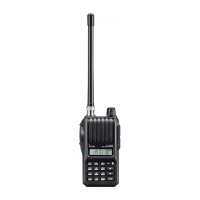24
5
6
■ General description
The transceiver has 207 memory channels, including 6 scan
edge memory channels (3 pairs), and 1 Call channel, for
storage of often-used frequencies.
D Memory channel contents
The following information can be programmed into a mem-
ory channel:
• Operating frequency (p. 16)
• Operating mode (p. 16)
• Duplex direction (+ or –) with frequency offset (p. 21)
• Reverse duplex function ON/OFF (p. 40)
• Subaudible tone encoder (p. 20), tone squelch or DTCS
squelch ON/OFF (p. 33)
• Subaudible tone frequency (p. 22), tone squelch frequency or
DTCS code with polarity (pp. 32, 33)
• Skip setting (p. 30)
• Tuning step (p. 16)
• Output power (p. 17)
• TX permission (p. 41)
■ Selecting a memory channel
D Using [] or []
q Push [VFO/MR/CALL] several times to select the memory
mode.
• “X” appears.
w Push [] or [] to select a desired channel.
• Only programmed channels are displayed.
D Using the keypad
q Push [VFO/MR/CALL] several times to select the memory
mode.
• “X” appears.
w To select a desired channel, enter the 3 digits of the chan-
nel number using the keypad.
• Blank channels are also selectable.
• Entering one or two digits, and then pushing [# ENT] also se-
lects a memory channel.
• Example— selecting memory channel “14”
■ Selecting the Call channel
➥ Push [VFO/MR/CALL] several times to select the Call
channel.
• “C” appears instead of the memory channel number.

